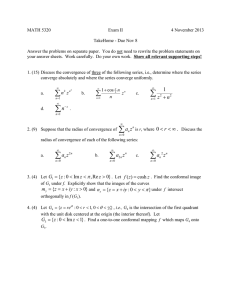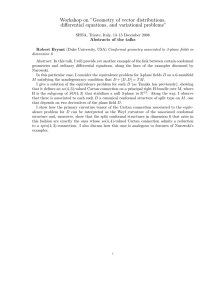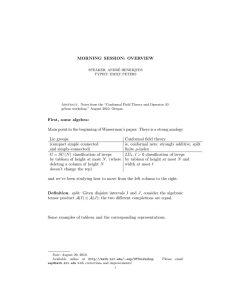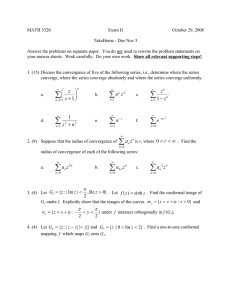MODULARITY OF THE CATEGORY OF
advertisement
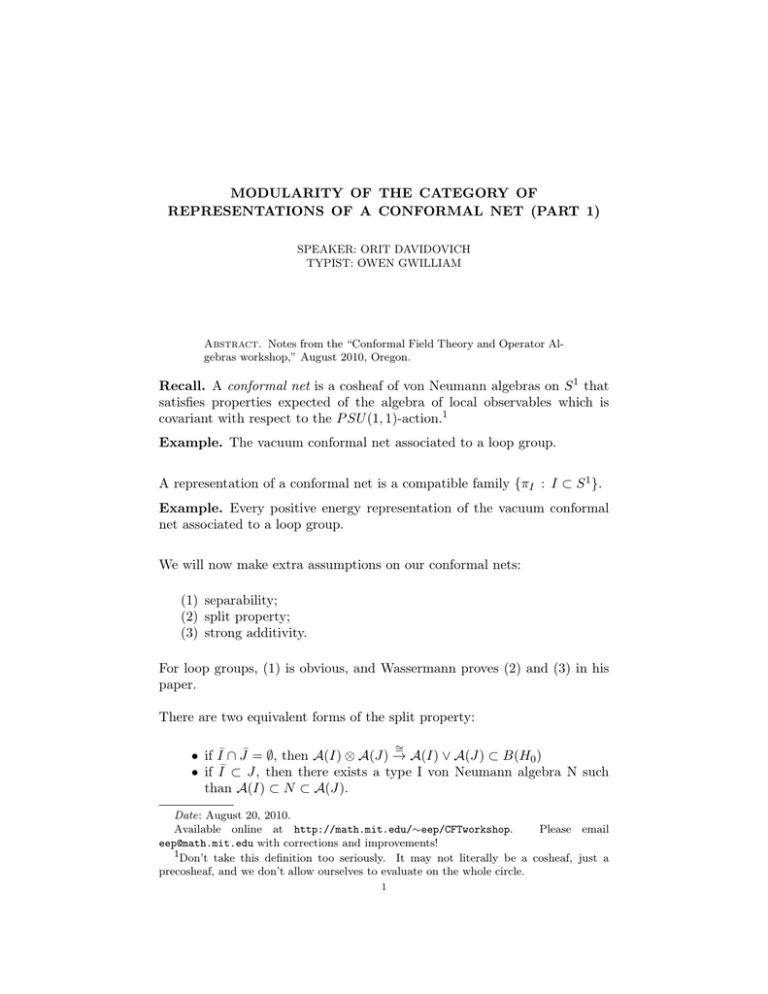
MODULARITY OF THE CATEGORY OF
REPRESENTATIONS OF A CONFORMAL NET (PART 1)
SPEAKER: ORIT DAVIDOVICH
TYPIST: OWEN GWILLIAM
Abstract. Notes from the “Conformal Field Theory and Operator Algebras workshop,” August 2010, Oregon.
Recall. A conformal net is a cosheaf of von Neumann algebras on S 1 that
satisfies properties expected of the algebra of local observables which is
covariant with respect to the P SU (1, 1)-action.1
Example. The vacuum conformal net associated to a loop group.
A representation of a conformal net is a compatible family {πI : I ⊂ S 1 }.
Example. Every positive energy representation of the vacuum conformal
net associated to a loop group.
We will now make extra assumptions on our conformal nets:
(1) separability;
(2) split property;
(3) strong additivity.
For loop groups, (1) is obvious, and Wassermann proves (2) and (3) in his
paper.
There are two equivalent forms of the split property:
∼
=
• if I¯ ∩ J¯ = ∅, then A(I) ⊗ A(J) → A(I) ∨ A(J) ⊂ B(H0 )
• if I¯ ⊂ J, then there exists a type I von Neumann algebra N such
than A(I) ⊂ N ⊂ A(J).
Date: August 20, 2010.
Available online at http://math.mit.edu/∼eep/CFTworkshop.
Please email
eep@math.mit.edu with corrections and improvements!
1Don’t take this definition too seriously. It may not literally be a cosheaf, just a
precosheaf, and we don’t allow ourselves to evaluate on the whole circle.
1
2
SPEAKER: ORIT DAVIDOVICH TYPIST: OWEN GWILLIAM
We want to consider separable representations (i.e., the Hilbert space is
separable) and nondegenerate representations (for any interval I and x ∈
A(I), if π(x)ζ = 0 ⇒ ζ = 0.
Remark: The identity in A(I) may not go to the identity in a representation
π. All we know is that it goes to a projection that commutes with π(A(I)).
Claim. π is nondegenerate if and only if πI (1) = 1H .
Let RepS (A) denote the category of nondegenerate separable representations
of A.
Claim. If the µ2 -index is finite, then RepS (A) is a modular tensor category!
Goal: Show RepS (A) is semisimple. That is it has finitely many irreducible
representations and every representation is completely reducible.
We’ll assume the finite index condition from hereon.
Definition. A representation π of A is localized at I ⊂ S 1 if
• π is defined on H0 (always the vacuum Hilbert space – the defining
representation of A)
• πI 0 = 1
Proposition 0.1. For π ∈ RepS (A), π is unitarily equivalent to a representation localized in any interval I ⊂ S 1 .
Proof. We’ll need the following facts about Type III1 factors:
(1) they are simple as algebras;
(2) every representation on a separable Hilbert space is also continuous
with respect to the strong operator topology;
(3) hence A(I) ,→ πI (A(I)), and
(4) π1 (A(I) is a von Neumann algebra so A(I) ∼
= πI (A(I)).
Yoh told us that any two representations of a type III factor are unitarily
equivalent. Thus there exists a unitary map u ∈ Hom(H0 , H) such that
uπI00 (x) = xu for all x ∈ A(I00 ).
Define ρI (x) = uπI (x)u∗ for all x ∈ A(I). By construction ρ is localized at
I0 and is equivalent to π.
Note. ρ localized at I0 insures that ρ(A(I)) ⊂ A(I) for every I ⊃ I0 .
MODULARITY OF THE CATEGORY OF REPRESENTATIONS OF A CONFORMAL NET (PART 1)3
Proof. Haag duality says A(I) = A(I 0 )0 . Thus ρI (A(I)) commutes with
A(I 0 ) = ρI 0 (A(I 0 )). Use locality in A and regularity.
Dimension: π an irreducible in RepS (A). Inclusion of type III1 factors
implies π(A(I)) ⊂ π(A(I 0 ))0 . The in dex [π(A(I 0 ))0 : π(A(I))] ∈ [1, ∞].
Example. M a factor then M ,→ M atk (M ) by diagonal matrices, and
[M atk (M ) : M ] = k 2 .
Proposition 0.2. For π an irrep, the index does not depend on the interval
I.
Heuristic idea behind proof: the index should only depend on the equivalence
class, so since π ∼
= ρ localized on any interval I, then the index should not
depend on the interval I.
Remark. Corbett assumed that representations were conformally invariant,
but if this index is finite, then the representation is conformally invariant
(though we might not know this a priori.
Definition. For an irrep π, the statistical dimension d(π) is the square root
of the index.
Theorem 0.1 (Longo). The statistical dimension and the quantum dimension agree.
Thus the index is the square of the quantum dimension, so if you prefer the
categorical notion of quantum dimension, you can stick to that.
Remark. if the index equals one, then a representation is invertible. That
is, you can find another representation that tensors with it to give the unit.
Now let’s consider the inclusion of two disjoint intervals I and J. Let E =
I ∪ J. Then A(E) = A(I) ∨ A(J) ⊂ B(H0 ). We have inclusion of type III1
factors A(E) ⊂ A(E 0 )0 .
Proposition 0.3. The index [A(E 0 )0 : A(E)] does not depend on E.
Definition. µ2 (A) is this index.
Claim. Given the extra assumptions on our conformal net A, if µ2 (A) < ∞,
then µ2 (A) gives an upper bound on the number of isomorphism classes of
irreducible representations in RepS (A).
P
Remark. µ2 = i d(πi )2 where i runs over isomorphism classes of irreps.
(Note that d(πi ) ≥ 1.)
4
SPEAKER: ORIT DAVIDOVICH TYPIST: OWEN GWILLIAM
Complete reducibility:
We want to make the universal enveloping C ∗ algebra of our cosheaf. There
is a subalgebra CS∗ (A) related to separability.
∗
If π isR a separable nondegenerate
R ⊕ rep of C (π) on H, then we can decompose
⊕
H = X Hx dν(x) and π = X πX dν(x).
Let R ⊂ π(C ∗ (A))00 act diagonally on H. There are two important possibilities: R is the center, and R is a maximal abelian
Here’s the strategy to disintegrate the representation:
(1)
(2)
(3)
(4)
use the central decomposition
show all the πx are type I
the πx are multiples of an irreducible
outside the null set, x 6= x0 then πx and πx0 are not multiples of the
same irrep
(5) there are only finitely many irreps so |X| is finite and thus our representation decomposes into a sum


